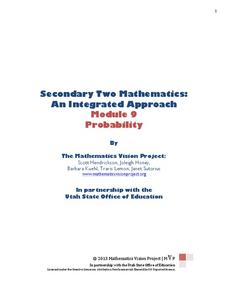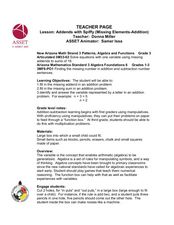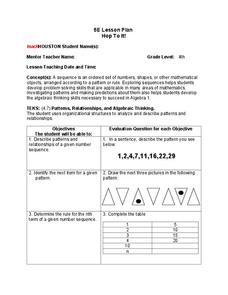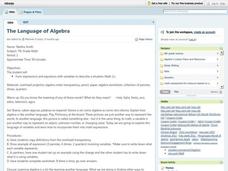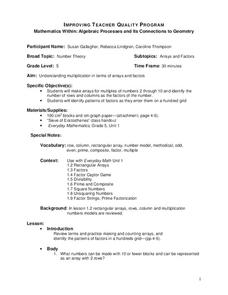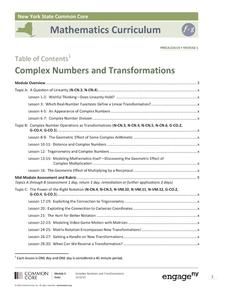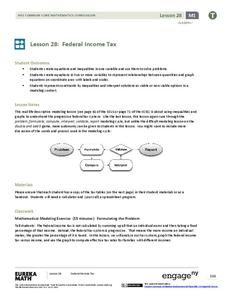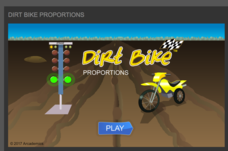Mathematics Vision Project
Probability
Probability, especially conditional probability, can be a slippery concept for young statisticians. Statements that seem self-evident on the surface often require a daunting amount of calculations to explicate, or turn out to be...
Curated OER
Addends with Spiffy
Students solve single variable equations. In this missing addend lesson, students solve problems with missing addends. Students create a function box to help study numerical reasoning.
Curated OER
Hop To It!
Students determine patterns. In this mathematics lesson, students act out a skit, play a sequence game, and complete patterns. Students use problems solving skills.
Curated OER
Algebra: What's My Rule?
Students apply higher level thinking skills to determine rules for sorting and classification. In this pre-algebra lesson, students nominate classmates who they think satisfy the unspoken "rule" established by the leader. As students are...
Curated OER
Algebra Match
Twelfth graders identify the parts of an algebraic equation. They consider the many uses of algebra in daily life. They play a game, Algebra Match, where student pairs work to solve equations listed on index cards.
Curated OER
Patterns, Functions & Algebra
Learners participate in numerous activities and games. In pairs, they play card games to find relationships between a random set of playing cards. After writing samples of Dear Abby letters concerning math problems, students create a...
Curated OER
A Math Game for Reinforcing Computation Skills
Students practice a variety of math skills. In this math computation lesson, students follow the rules of the game and keep track of their own scores. Students review skills for addition, subtraction, multiplication and division.
Curated OER
The Language of Algebra
Learners compare the language of algebra to a foreign language. They play the game "Pictionary" to emphasize that pictures can represent words. After writing definitions and discussing the meaning of variable expressions, students, in...
Curated OER
Review of Algebra Topics
Eighth graders participate in a lesson that is intended to review topics of Algebra.They investigate the concepts of percent and solve problems. Students also solve equations that involve percent of change.
Curated OER
Algebra Applies to the Real World? No Way!
Sixth graders examine the connections between math and real life. In this algebra lesson, 6th graders use Algepairs Cards to complete the problems presented and discuss how algebra relates the real world.
Curated OER
Mathematics Within: Algebraic Processes and Its Connections to Geometry
Fifth graders discover the connections between algebra and geometry. With a focus on arrays and factors, they are introduced to multiplication. They develop an array for multiples of 2 through 10 and identify the factors of each row....
Curated OER
General MacArthur's Favorite Number Game
For this secondary mathematics worksheet, students examine the algebra behind the solution of General MacArthur’s favorite mathematics trick. The one page worksheet contains one problem with the solution.
Curated OER
Visual Structures of Postulates and Axioms in Algebraic Operations
High schoolers investigate Axioms and Postulates. In this proof and linear transformation of equations lesson, students explore axioms and postulates to solve linear equations. High schoolers construct game cards to analyze the linear...
Curated OER
Algebra Vocabulary
In this Algebra I worksheet, 9th graders match vocabulary words to their definition in the Concentration game format. The one page interactive worksheet contains 20 matching questions and is self checking.
EngageNY
Recursive Formulas for Sequences
Provide Algebra I learners with a logical approach to making connections between the types of sequences and formulas with a lesson that uses what class members know about explicit formulas to develop an understanding of...
EngageNY
Complex Numbers and Transformations
Your learners combine their knowledge of real and imaginary numbers and matrices in an activity containing thirty lessons, two assessments (mid-module and end module), and their corresponding rubrics. Centered on complex numbers and...
EngageNY
Federal Income Tax
Introduce your class to the federal tax system through an algebraic lens. This resource asks pupils to examine the variable structure of the tax system based on income. Young accountants use equations, expressions, and inequalities to...
Arcademics
Dirt Bike Proportions
Dirt Bike Proportions is a multi-player racing game that allows students from anywhere in the world to race one another while completing equivalent proportions!
Curated OER
Graph Mole
Practice graphing ordered pairs by playing an online graphing game. Learners will discover why it is useful to plot coordinates on a xy plane. Graph Mole, is the online game that allows them to practice through a fun, interactive story....
Curated OER
Incredible Integers!
There are three parts to this lesson on integers. In the first, learners explore positive and negative numbers on an actual painter's tape number line and by playing a "Hot Seat" game. In part two, they view a BrainPop video and work...
Curated OER
Interesting Integers and Exciting Equations
An 80-page resource provides four lessons and all associated worksheets to teach middle schoolers about expressions and equations. The lessons are hands-on, using games, "integer chips," a balance and cubes, and cut and paste activities....
District 158
Plan an Adventure
For kids, taking a vacation is all fun and games, but after completing this pre-algebra project, they'll have a whole new appreciation for the planning that makes these trips possible. Given a budget of $5,000 to spend on purchasing the...
EngageNY
Writing and Expanding Multiplication Expressions
Find out what's so standard about standard form. Scholars learn to write multiplication expressions with variables in the 10th lesson in a series of 36. They use different symbols for multiplication and translate between standard and...
West Contra Costa Unified School District
Solving Inequalities
What does translating points on a number line have to do with solving inequalities? Young mathematicians first learn about translations of points on a number line, and then use this information to solve linear inequalities in one variable.
